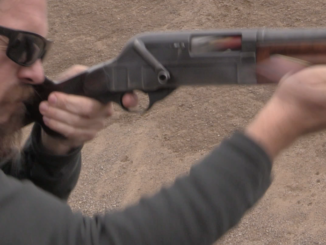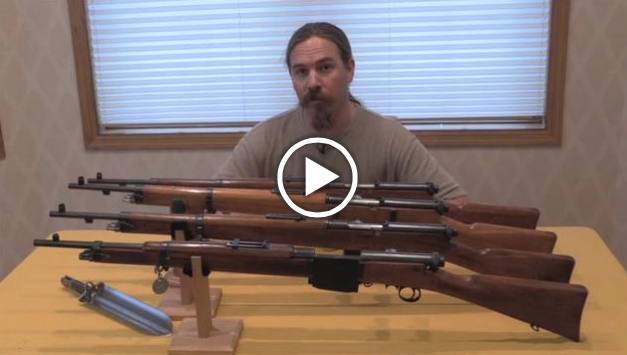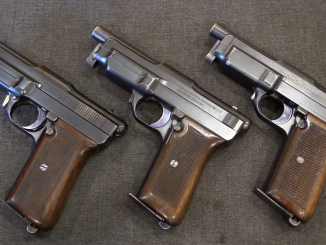This is a lot in the upcoming February 2020 Morphy Field & Range auction.
Adopted by Bavaria in 1869, Johann-Ludwig Werder’s breechloading rifle was a brilliant piece of engineering, offering an automatically ejecting falling-block system with a remarkably high effective rate of fire and a wonderfully modular system of parts. Removing a single screw releases the entire breech and fire control system as a self-contained unit for easy maintenance and servicing.
The Werder was made in rifle, carbine, and pistol form, with the carbines and pistols chambered for an 11x35mm short cartridge (340 grain bullet over 66.4 grains of black powder), while the rifle used an 11x50mm cartridge (386 grain bullet over 66.4 grains of black powder). The rifles saw a relatively short service life, as attempts to convert them to 11mm Mauser (11×60) were plagued by problems (the Mauser cartridge being substantially more powerful than the original Werder cartridge). The pistols and carbines were not converted in this way, but left service at the same time that the rifles did.




So much for the lightning fast action, but why not sell the design on the commercial market instead of tossing it out as a failure altogether? It’s not like the 11x50mm cartridge was too weak to take down deer or shoot targets in competition… I could be wrong.
“(…)tossing it out as a failure(…)11x50mm cartridge(…)targets in competition(…)
Indeed there existed target version of that cartridge, namely DWM 26A
see photo: http://municion.org/11/11_5x50RWerderTarget.htm
so I presume target version of “(…)lightning fast action(…)” was sold.
“(…)deer(…)”
According to https://naboje.org/node/5095 original version throws 21,70 g with muzzle velocity 445 m/s
Note that last known specimen presented is stamped 1888 which suggest that this cartridge production ceased no earlier than 1888.
Well, there was a a little problem with that, namely that the basic Werder breechblock was a copy of the patented Peabody action. One that no royalties had been paid on, or any license negotiated for its use.
Peabody literally fought the Austrian government in court for years to obtain proper compensation for the use of his design, and never got it. In the process, the Austrian government ended up incurring legal expenses that were several times the amount it would have cost them to simply buy the rights to use the Peabody breech and pay the man the royalties.
With that headache to cope with, they probably decided that trying to market a commercial version (say, through Steyr, who were already in existence and in the arms export business at the time) would likely set off another round of legal problems and cost them more than they would get from sales.
In short, the Austrian government may have concluded that it just wasn’t worth the aggravation.
cheers
eon
“(…)Austrian(…)Austrian(…)”
But why that is important, when we discuss design made in Bayern?
I think we should have asked about which countries manufactured the guns… Bavaria might have subcontracted production to outside armories as well. I could be wrong.
That would make a really cool garage project. Any technical drawings or patent images available?
“(…)technical drawings(…)”
After quick search I found cut-away drawing of action, see 1st drawing from top:
http://www.figuren.miniatures.de/gewehr-werder-1869.html
Given the date of it’s trials. Was it tested against and if so how did it compare with Colt (or similar / comparable) revolvers. Which ‘even in their early forms’, I would have thought would have been clearly superior.
Though it appears among the better of the single shot pistols of the period and sharing the same ammunition as the carbine a good idea.
The drawback to the early colt revolvers were you got six fast shots then had to reload. With either the black powder guns or early cartridge revolvers was a time consuming operation . Don’t forget you had to manually eject and index the cylinder then reload each chamber with the early cartridge revolvers.
“(…)Which ‘even in their early forms’, I would have thought would have been clearly superior.(…)”
Generally yes, but anyway some single-shot metallic cartridge pistols were bought by military for example Remington’s The 1865 Navy pistol. https://unblinkingeye.com/Guns/RRB/rrb.html
Also while revolvers provided ability to fire quicker, keep in mind that in 1869 many forces still have considerable amount of percussion single-shot pistol in service.
For example this: http://armesfrancaises.free.fr/pist%20mle%201822T.html
was used de 1847 à 1874 environ [I presume: …by France]
Yes Daweo, during the Napoleon III & Maximilian von Hapsburg imperial “Mexican adventure” the French armed forces only allowed officers to use revolvers. The NCOs and lesser beings and lower orders had to make do with single-shot pistols if they required such a side arm. Meanwhile, the Juarista chinacos sometimes carried more than one revolver, a bit like the irregulars and guerrillas and bushwhackers in nearby seceding North American States.
Let’s not overlook the genius Belgian police pistol of the same period, namely, a *two shot* rolling block pistol to augment the issue saber and replace the single-shot pistol that was carried formerly! It would be interesting to determine if the origins of the common police truncheon began with a single-shot pistol when empty? I’m sure that in the UK it arose as a cudgel and is not tied to any ponderous old single shot…
In the United States postal carriers often have an irritant spray against dogs.
In 1840s Norway, it was thought a proper postal carrier side-arm would be a combination pistol/saber! I guess wolves–and perhaps trolls?–are a menace there as well as feral or vicious dogs?
https://www.forgottenweapons.com/ria-double-barrel-percussion-knife-pistol/
Could you give me a call about an old gun that I have. It is an 1873 trapdoor Springfield but not a .45-70. My number is 928-701-1259. Thanks in advance.
Most likely a Trapdoor Forager shotgun. Was designed for hunting small game for troops while in the field. Made in 29 gauge for brass hulls.
Not a shotgun. we measured and it fit a .30 30 shell in it and has rifling in the barrel
The M1869 Werder “Blitz” (“lightning”) would become VERY precious in the Franco/Prussian-War of 1870/71! As it was the only rifle (available in numbers) on the Prussian side that had the range of the French Chassepots.
In the beginning only 4 Bavarian Jägerbatallione (“hunter batallions”) were armed with it. Bavaria had been fully independent in their choice of arms and gone for the “best” they could get (from Bavaria, Nuremberg that is).
Prussian soldiers were clearly outclassed (and -ranged) with Dreyse needle rifles. Every time French positions could use their superior range casualties on the Prussian side would be substantial (especially with bone headed officers in charge, much the same as during the Great War).
And this disadvantage would last to the point until the Bavarians were called to help – or Prussian artillery arrived to save the day.
Field guns tend to make the other team miserable on open ground, especially when their own fire support is missing. To my knowledge, any sufficiently supplied battery of heavy field guns has been the main battle tank’s worst nightmare…
How do you define:
heavy field guns
?
In most armies, field guns up to the American Civil War had generally been 6-pounder smoothbore muzzle-loaders.
In the 1850s, the French Army introduced the 12-pounder “Napoleon” smoothbore gun/howitzer, that fired a shot, shell, or spherical case twice as heavy as its predecessors. (Incidentally, its designer named it in honor of Emperor Napoleon III; the Emperor himself had nothing to do with designing it.)
By the time of the Franco-Prussian War, most countries were experimenting with breechloading artillery, at least for field guns, and the Prussians, or rather Krupp, were no exception. The result was the 8cm C64 BL;
https://en.wikipedia.org/wiki/C64_(field_gun)
Followed by first the 9cm K/73;
https://en.wikipedia.org/wiki/9_cm_Kanone_C/73
And then the 7.7cm FK/96;
https://en.wikipedia.org/wiki/7.7_cm_FK_96
All of the above fired heavier projectiles, to a longer range, than those of the 12-pounder smoothbores on the “other side(s)”. So, by the standards of their day (the late 1860s to the turn of the 20th Century) they were indeed “heavy field guns”.
cheers
eon
Will a long gun of 10 cm (or larger) bore diameter count as a heavy field gun? I am also trying to exclude railway guns.
10cm back then would have been defined as a siege gun. Going back to when field guns were called “culverins” and had lighter, longer barrels than siege guns of the same bore size, which had shorter, thicker-walled barrels with heavier breeches for firing battering charges to knock down fortress walls.
Those big bruisers were the ones actually called “cannon”, which prior to about the Napoleonic Wars was a term for a big gun of a specific size, tube weight and length, and shot/shell weight.
Here’s one of the better “primers” on that hideously convoluted subject:
Artillery Through The Ages- Manucy 1949
at Project Gutenberg;
http://www.gutenberg.org/files/20483/20483-h/20483-h.htm
and at archive.org;
https://ia800307.us.archive.org/17/items/artillerythrough00ages/artillerythrough00ages.pdf
The cross-sections of various guns’ tube diameters and wall thicknesses are especially illuminating.
cheers
eon
Yes, the Werder Blitz was much supeiror to the Podewils cap lock combustible-cartridge breech loader the majority of the Royal army of Bavaria was armed with! Still, with that said, I contemplate the horrendous mass slaughter of the Civil War in the United States, and cannot help but feel that the Norwegian Kammerlader–itself based on the U.S. Hall breech-loader, and the Bayerisch Podewils-Lindner capping breech-loader were within the capacity of U.S. Ordnance to replicate during the War of the Rebellion/ Late Unpleasantness/ War Between the States/ etc. etc. Shocking. All goes to show that there are limitations of the weapons and limitations on how these are employed…
A single action trigger with a single action spring supported breech block… All subject to go out of business through an impact or drop… Seems nearly a nominate to a contest for dumpest handgun being able to be made by a cleverest designer… lMHO…
Cause of two levers to work the action should be the existing Peabody patent at that days. The inventor seems to make a different lay out not to infringe Peabody’s patent. From service handgun point of view, this seems inferior to Peabody’s but a contest gun, it seems superior. lMHO.
Ian was right. This was a cool system. For sustained fire, it appears to work better than repeaters of the period. On the other hand there were several revolver designs in 1868, some using metallic-cased cartridges. There were repeating carbines using what would be regarded as pistol ammunition today–two were the Spencer and the Henry. It’s interesting to see how different organizations answered their small arms needs.
For a pistol cartridge, the 11x35mm short cartridge might have been unpleasant to shoot with a heavy 340 grain bullet over 66.4 grains of black powder. The Remington 1858 percussion revolver in .44 caliber fired a 140 grain bullet over 35 grains of black powder. Depending upon who was shooting the 1858 revolver, it had effective ranges of ten feet or three hundred feet. The “rifled musket” was new, and the breech loading rifled musket was revolutionary at the time, but low black-powder muzzle velocities made for high trajectories. Ranges were short and even though fire volume had increased over the two or four shots per minute with muzzle loaders to more than a dozen shots per minute with breech loading single shots, the increased range was what captured the attention of the brass.
I have a replica Sharps 1863 breech-loading sporter (paper cartridges) and its sight is calibrated to 800 yards. Interesting that thirty years later the small bore smokeless powder repeating rifle had sights calibrated out twice as far.
https://www.davide-pedersoli.com/scheda-prodotto.asp/l_en/idpr_195/rifles-1859-e-1863-sharps-1863-sharps-sporting.html
Tactics didn’t keep pace with hardware. Even though tested, the military combat leaders seemed to have a vague notion of what their small arms fire could achieve.
How far were those sights calibrated for?
It is still cool.
If you want to see more on the Werder, the Chap on Bloke on the range YT channel made a comprehensive video on this system. He even gone to the trouble of making a transparent side plate to show the mechanism in action with the springs in place.
Regarding artillery units, their first self defence weapon was canister or grapeshot. Artillerymen were not expected to fight with small arms.
The time required to train them and the cost and tactical value of their guns made them too valuable for this. They were expected to get away with their pieces before being overran by the enemy.
Their small arms were primary there to dispatch wounded or out of control horses. Sad but necessary.
I don’t think that pistol cartridge loading is physically possible, on two lines of analysis, while a third makes me question the plausibility of its adoption even if it were:
(1) This forum thread: https://forums.gunboards.com/showthread.php?1103751-11-5x35mmR-Werder-Cartridges , in which the author indicates that the heaviest powder load he was able to seat a 15% lighter (288 gr) bullet over was less than 2/3 as much as you’re citing here (possible with 2.5 g = 38.6 gr, but not with 2.6 g = 40.1 gr).
(2) My back of the envelope math: going off the dimensions I’ve seen, and some generous estimates for the ones I haven’t, I get that the case capacity of the Werder pistol cartridge should be between 20% and 25% larger than that of the .45 Colt, for which a maximum load (which can be difficult to load in modern, thicker brass) is a 255 grain bullet over 40 grains of BP. That puts the Werder bullet you’re citing 33% heavier, and the power load, 66% heavier, all in
(3) As a general rule, European service pistol cartridges of that era tended to be a good deal weaker than US pistol cartridges, right? So how likely is it that Bavaria, while adopting a slightly milder rifle cartridge than the US (.45-66.4-386 vs. .45-70-405 (or technically, in 1869, still .50-70-450)) adopted a *much* heavier pistol cartridge (.45-66.4-340 vs. .45-40-255 (or, technically, in 1869, still .44-30-216 paper-cartridge, conical-ball loadings of cap-and-ball revolvers)).
Even the US army felt it necessary to tone down the original .45 Colt loadings in the end, to .45-28-230. From a carbine would be one thing, but I have to imagine that from a pistol, .45-66.4-340 would be downright brutal.
How confident are you in the accuracy of your source?
(Copied from Youtube, to improve the odds of its being seen by Ian and/or other people more informed than random Youtube commenters; apologies for any redundancy.)
I have two of these, one even with a detachable wooden stock. My local gunsmith analyzed both and stated that the quality of the barrel, breech block and all the rest would be strong enough to convert it into a .44mag, but as the pistols are now more than 150yrs old and I didn’t want to go hunting elephants either ;-), I let them convert to .45 Long Colt instead.
And what shall I say: It is absolute fun shooting them! Thanks to the long barrel, it is no problem to shoot these oldtimers on 50 yards with high accuracy.
Due to the heavy weight (everything is solid steel..) and the long barrel, the feeling to shoot these guns is something in between a pistol and a rifle. But at least to me, that just adds to the fun!
BTW: Johann-Ludwig Werder was only a “self-made gunsmith”! Originally, he had completed vocational training as a locksmith. And that you see with the cool mechanism! When decocked, none of the three springs is under tension, so no parts may jump around when you disassemble it.
-I can only recommend you to get your hands on such a baby if you get a chance for it. As they were just 4yrs in operation in the army and are rock solid constructed, they are all in an incredible good condition.
Have fun!